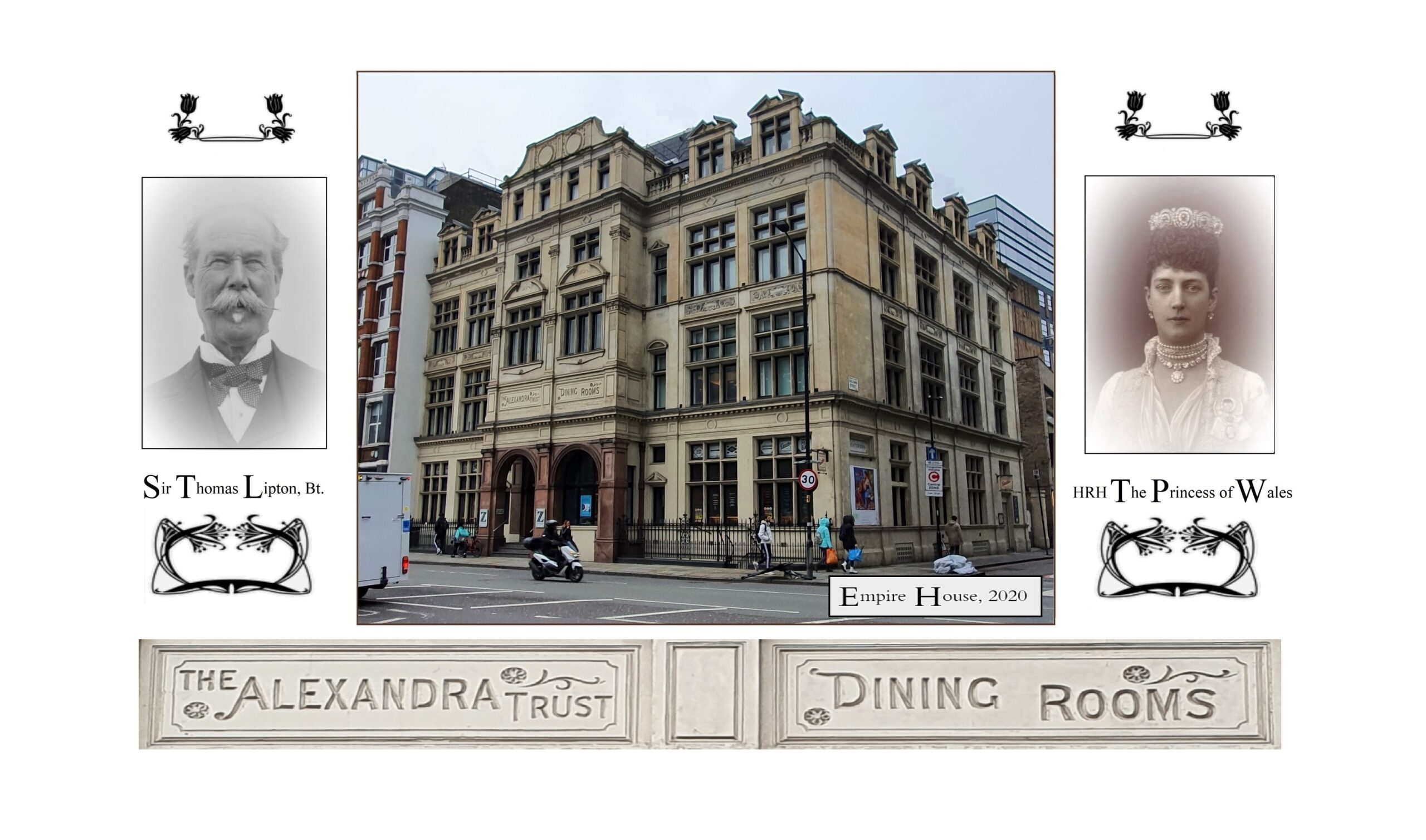
Welcome to the story of the Alexandra Trust Dining Rooms. I’d planned a simple post about the life and times of this interesting late-Victorian building on the City Road, a short distance north of the Square Mile. However, it quickly became apparent that coverage of the building in newspaper archives gives small but vivid insights into the reality of poverty in the East End in the early 20th century, and the attitudes of royalty and the establishment to that reality.
An Announcement – 1898
On the 8th of August, newspapers report a plan to provide cheap meals at cost price in a series of counter-service restaurants in the poorest parts of London. Sir Thomas Lipton, wealthy grocer and philanthropist, is prepared to spend £100,000 on building them; after the initial outlay the scheme should be self-supporting. HRH the Princess of Wales – Princess Alexandra, wife of the future King Edward VII – lends her patronage. The scheme builds on her Diamond Jubilee meal for the poor in 1897, for which the then-Mr. Lipton had donated £25,000 of the required £30,000, and which succeeded in feeding 300,000 people. He was knighted at the start of 1898.
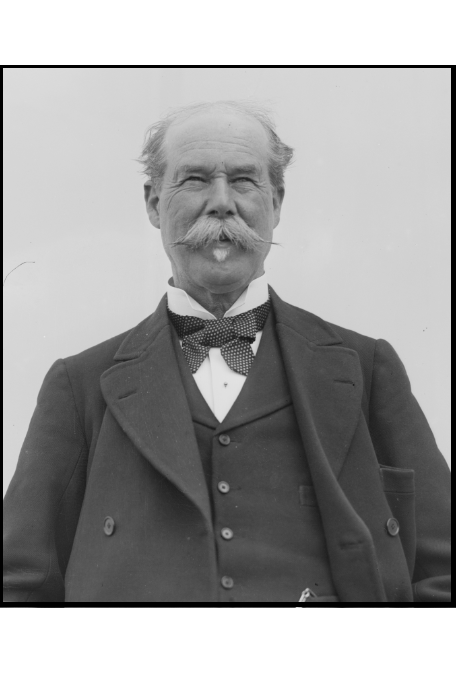
← Besides being a millionaire grocer, philanthropist and owner of a spectacular moustache, Sir Thomas Lipton was also a yachting fanatic and keen early motorist. In early 1903 his chauffeur was convicted of speeding as he rushed to get Sir Thomas to the launch of his latest yacht, and was fined £5. The speed limit for cars at the time was 14 mph.
Lipton’s cheerful demeanour in the face of repeated failure to win the America’s Cup earned him the title ‘the best of all losers’
Fighting poverty may be fashionable among late Victorian royalty and wealthy society, but those with vested interests are quick to react against Lipton’s plans. On the 17th of August, the St. James’s Gazette worries that the scheme, with its proposed marble tables, courtyards, fountains, shrubs and lunch for 2ᵈ, will put coffee houses out of business. On the 31st of August, Alexandra receives a petition from the London Coffee and Eating-House Association, suggesting she has been misled by Sir Thomas and the scheme is not a charitable endeavour but a business proposal. There is some truth in this, but she fails to offer any redress. On the 8th of September, the same newspaper reports that the London Master Bakers Protection Society has petitioned the Privy Council to refuse a royal charter for the newly constituted Alexandra Trust. This also fails. A letter to the Times on the 27th of September criticises the scheme for being liable to create a dependence among ‘this class’ on charity, due to the pernicious habit of indiscriminate alms-giving. Idle loafers, selfish husbands, drink and pleasure also feature heavily in Mr J. Henry Griffith’s diatribe. Mr Griffiths is chairman of the Birmingham Charity Organization Committee.
A Triumphant Opening – 1900
In spite of the protests, the London Daily News reports the opening, on the 9th of March, of Empire House, 136-144 City Road. It has three floors of dining rooms each designed to hold 500 people – a number frequently exceeded in later years. Kitchens are on the top floor. Illustrations in the Sketch show an entrance hall and staircase that are both stylish and utilitarian, with shrubs, mosaic flooring and stone columns – but no fountains. The facade is in Bath Stone with the entrance in red Aberdeen granite. The Morning Post reports that the basement includes washing facilities for customers and an artesian well yielding 2,000 gallons of water an hour, and that 1,200 steak puddings can be cooked simultaneously. There are ‘electric automatic lifts’ to aid distribution of food to the dining floors, and a bakehouse with electric kneading. The Sketch describes the establishment as a type of slap-bang – an archaic noun meaning a low eating house. Soup, steak pudding with two vegetables and a pastry costs 4½ᵈ.
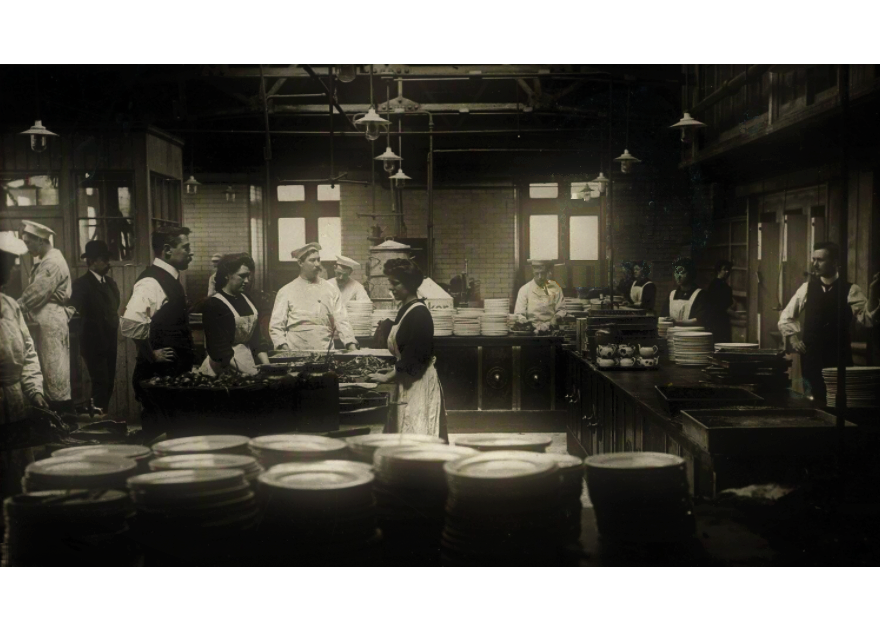
← The kitchens
Customers pay at the entrance; they receive tokens in return and exchange these for food in the dining areas. Alexandra makes an official visit soon after opening, obtains her tokens and opts for soup, steak pudding and plum duff. However, she takes only a mouthful each of the first two and none of the last, says the Illustrated London News of the 7th of April in its ‘Ladies’ Page’, in among the latest fashion in afternoon dresses and titbits from Buckingham Palace. The author snidely implies that a meal produced for such a low price must be of a similarly low quality. Alexandra is shocked to be told by the manageress that it is the habit among the lower classes to wash only after a meal, not before.
Empire House is ideally placed just 100 metres north of the Old Street/City Road junction, the meeting point of a number of tram routes used by factory workers, and it is so successful that it becomes a popular stop for wealthy American tourists to marvel at the huge amount of food prepared and served each day. However, despite this success and Lipton’s grandiose plans, no further dining rooms are built – perhaps due to the earlier criticism.
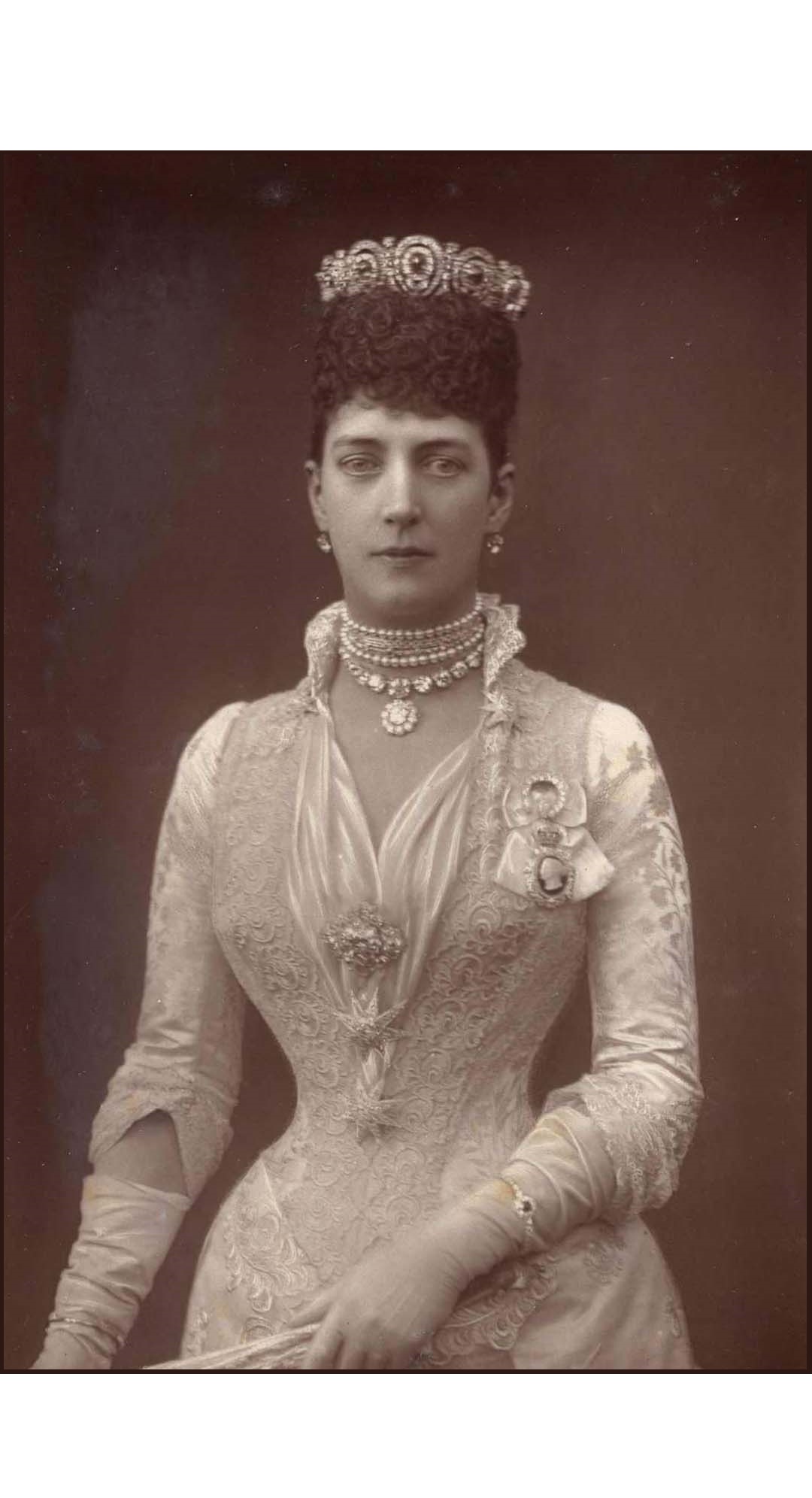
→ HRH The Princess of Wales, later Queen Alexandra. Not a fan of cheap plum duff, nor the supposed washing habits of the lower orders.
The Glory Years – 1901-1908
On the 10th of February 1901 the Civil & Military Gazette of Lahore reports on ‘London Improvements in 1900’ for homesick Raj administrators and Colonial types coming to terms with the end of the Victorian era. It describes Empire House as ‘a handsome stone building looking like a town hall’. On the 13th of April it reports further that the Trust, on the suggestion of the now-Queen Alexandra, will also provide hot meals to elementary schools within a 3-mile radius, at ½ᵈ per head, and to ‘bed-ridden folk and other invalids who cannot leave their homes’. There’s no evidence this meals-on-wheels service actually materialises. The Gazette goes on to discuss the ‘bad cooking and wasteful economy’ of the working class.
The London Daily News notes on the 18th of December that a dinner is to be given by the Queen for widows and children of soldiers killed during the 2nd Boer War. Edwin Moss, who runs the London Colosseum, arranges the entertainment. Each attendee gets a card portrait of the Queen (gawd bless ‘er) and each child a toy. This starts a trend for events involving the ‘deserving poor’ at Empire House. For example, on the 4th of January, 1902 the Sunday Times employs sugar-coating to report, in an article romantically titled ‘London’s Waifs and Strays’, that the Dickens Fellowship is entertaining 3,000 poor children over 3 days there.
Lipton’s knighthood is upgraded to a baronetcy the same year.

← The men’s dining room on the 2nd floor, 1905. Men and women dined in separate rooms – the trustees didn’t want any of that sort of thing going on in an institution for the poor.
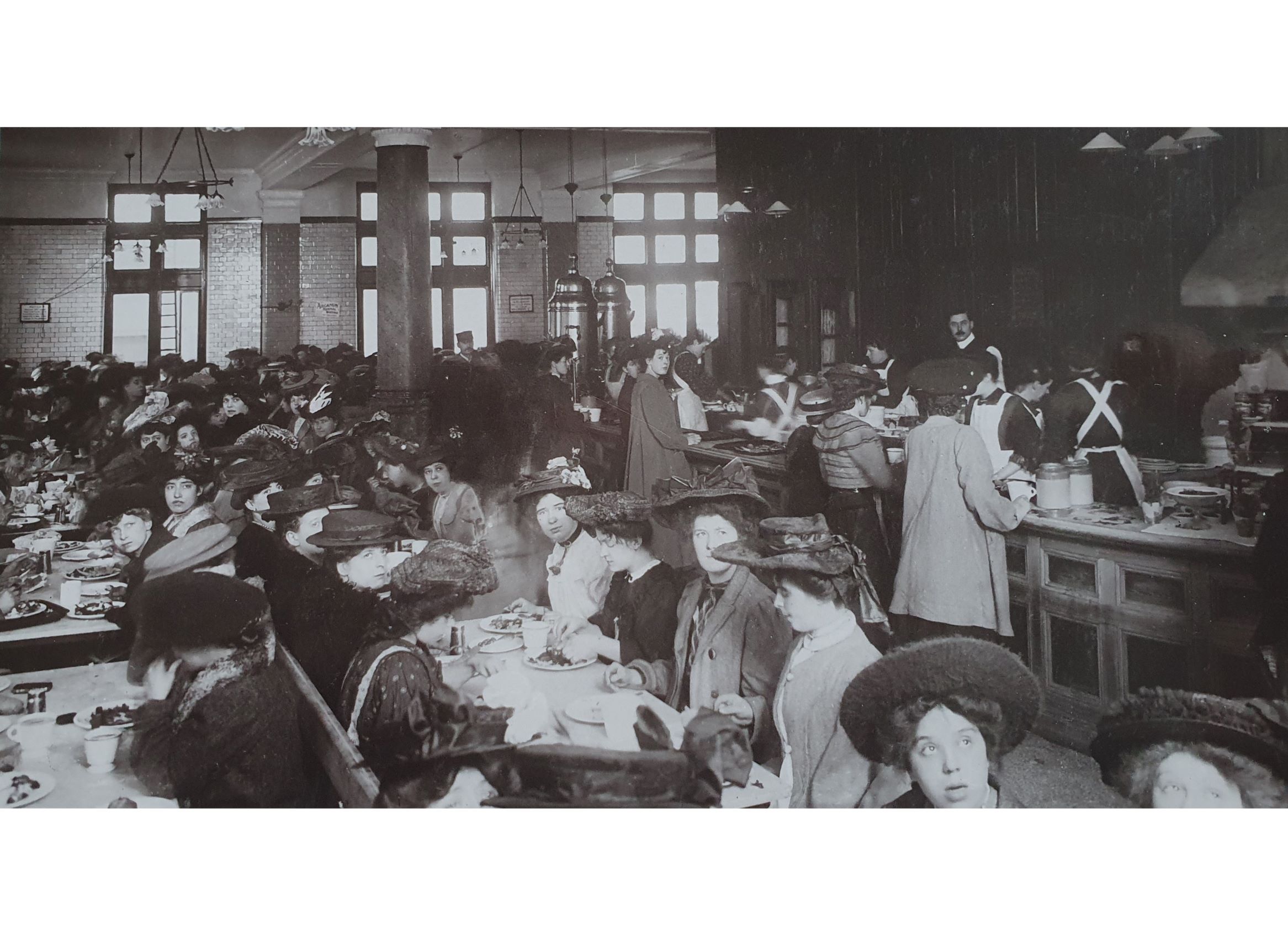
← The ladies’ dining room on the 1st floor, from a similar angle
On the 23rd of December 1906 Reynolds’s News, a left-leaning weekly, holds its annual dinner for 2,000 sandwichmen, who walk the streets with advertising boards for a pittance. It has previously applied to use the historic Guildhall for this event, but each request has been rejected by the City authorities. The request is a deliberately provocative political act, and the debates in the City’s Common Council show it is the political stance of Reynolds’s that ensures the rejection of both the request and a proposal to donate money in lieu. The Local Government Journal , sounding as right-wing as Reynolds’s is left, dismisses the sandwichmen as ‘wrecks of Society – the flotsam and jetsam which has drifted into the gutter through the want of moral fibre’. In contrast, Reynolds’s describes a typical sandwichman as ‘a respectable man, and, unhappily, exclusively British born. He does not drink, nor utter foul language, nor beg. He is drawn from all classes of society and, to a considerable extent, from the ranks of old soldiers.’ This description is a balancing act, trying to elicit donations by employing a canny combination of truth, implicit racism, patriotism and rose-tinted spectacles to reassure readers the sandwichmen are the ‘deserving poor’. Without the Guildhall, Lambeth Public Baths have been used for the dinner until the switch to Empire House this year.
On the night, the Stepney Gas Workers’ Brass Band welcomes the men, and they receive tobacco, cigarettes and pipes from donating companies. With this, ‘[t]he squalid helplessness which seemed to sit on the men as they filed in vanished’, claims Reynolds’s in its report of the occasion. Telegrams and letters of support on the evening come from the King, who each year donates £10, the Queen, the Prince of Wales and Sir Thomas Lipton. No doubt such communications contribute to the attendees eating with ‘spirit and gusto’. The menu consists of:
Vocalists and eccentric comedians are among those providing entertainment. Each man receives one item of clothing, a pack of Lipton’s tea and a shilling as they leave.
Feeding Children, Failing Health & Safety – 1909-1914
The Times reports on the 6th of February 1909 that a coroner’s jury has returned a verdict of accidental death on Henry Murr, 47, a market-garden carman of Tottenham. Murr had been at Empire House to collect refuse. He walked under a descending goods lift to collect a bin and his neck was broken; he died later in hospital. The jury notes that the lift should have been better protected. The building manager states that the Trust cooks 9,000 meals daily for factory workers and schoolchildren; this and its royal patronage perhaps prevents a more serious verdict being returned.
Soon after, the Education Committee of the London County Council (‘LCC EC’) accepts the tender of the Trust to supply meals for schoolchildren for 4 years. The Times reports on the 11th and 17th of February, that the number of ‘necessitous children fed in the week ending 29th January’ was 49,926, and the tender is to supply between 5,000 and 30,000 meals per day, at a cost of about 1´6ᵈ for 10 children. On the 5th of March, 1910 the Hoxton Market Christian Mission appeals in the Times for funds to continue feeding 2,000 children a meal 6 days a week at Empire House. On the 26th of March, 1912 the Times reports that an ongoing coal strike has resulted in the LCC EC considering cancelling the Easter holidays to ensure ‘necessitous children’ can be fed in warm school buildings. On the 5th of December, the Trust agrees to supply an additional 5,000 children’s meals a day.
The Pall Mall Gazette reports on the 13th of October 1913 that the Trust has been summoned to court for providing bread and dripping to the Salvation Army shelter on Commercial Road unfit for human consumption. On the 17th of December, the Times notes that the Children’s Happy Evenings Association, which provides healthy recreation and amusement for poor children, is celebrating its 25th anniversary with meals at Empire House. I can only hope that food storage improved between October and December.
Fading into Obscurity – 1915-1950
In December 1915 the last sandwichmen’s dinner is held; the number entertained drops to 1,500. The Great War, removing vast numbers of men from the workforce and thus providing better opportunities for those left behind, perhaps reduced the number of sandwichmen to the point where the event was no longer viable. Coverage of Empire House in the press after this year is minimal – the ‘deserving poor’ either no longer exist or their needs are lost among the exigencies of war.
Queen Alexandra dies on the 20th of November 1925 and Sir Thomas Lipton follows on the 2nd of October 1931. A lifelong bachelor, his will consists mainly of bequests to charities, hospitals and other deserving organisations, many in his native Glasgow. Staff at the Alexandra Trust send a wreath to his funeral, but the Trust is not mentioned in his will.
William and Alice Henderson are listed as residents of Empire House in the 1939 national register – a census to enable ID cards to be issued. William, 54, is listed as ‘Caretaker and Supervisor’. His wife, 64, does ‘unpaid domestic duties’ – housewife in census-speak. In 1940-41 the building suffers moderate blast damage in the Blitz.
Closure, Afterlife & Time to Reminisce – 1951 onwards
The Dining Rooms close in or shortly before 1951; no reason is reported, but demographic trends and wartime bombs mean the area’s immediate population has dwindled, and schools have long since started to cook meals onsite. The Daily Telegraph of the 5th of June includes an official notice of the proposed sale of the building by the trustees for £61,000 (about £2m today). In January 1952 the Times confirms the building has been sold. The purchaser is Sobranie Ltd., upmarket tobacco manufacturers, and the address appears on some of their products between 1953 and 1959. In 1960 the building is sold again, to a firm of printers, beginning a long period of decline. Later it is converted into offices.
The Trust, drifting into insignificance and out of catering, registers as a charity in 1962.
A Daily Mirror reader writes to the ‘Old Codgers’ column on the 3rd of May 1966, reminiscing about visiting Empire House for high tea from the Hoxton Market Christian Mission with 2,000 other children, marching the short distance between the two in the middle of the road, singing hymns behind a grey-bearded man called John Burtt. The Mission was founded by brothers John (‘the bishop’, d.1925) and Lewis (‘Daddy Burtt’, d.1935), Hoxton saddlers by trade, to provide poor children with meals and poor families with holidays. Further letters published in response recall that children would stuff plum duff in their pockets to eat later. Two women would stand at the stairs, one with sponge and water, one with a towel, to clean the children’s faces after the meal. The Mission also had a ‘penny a week’ boot club – a form of cheap rental so children would not go barefoot.
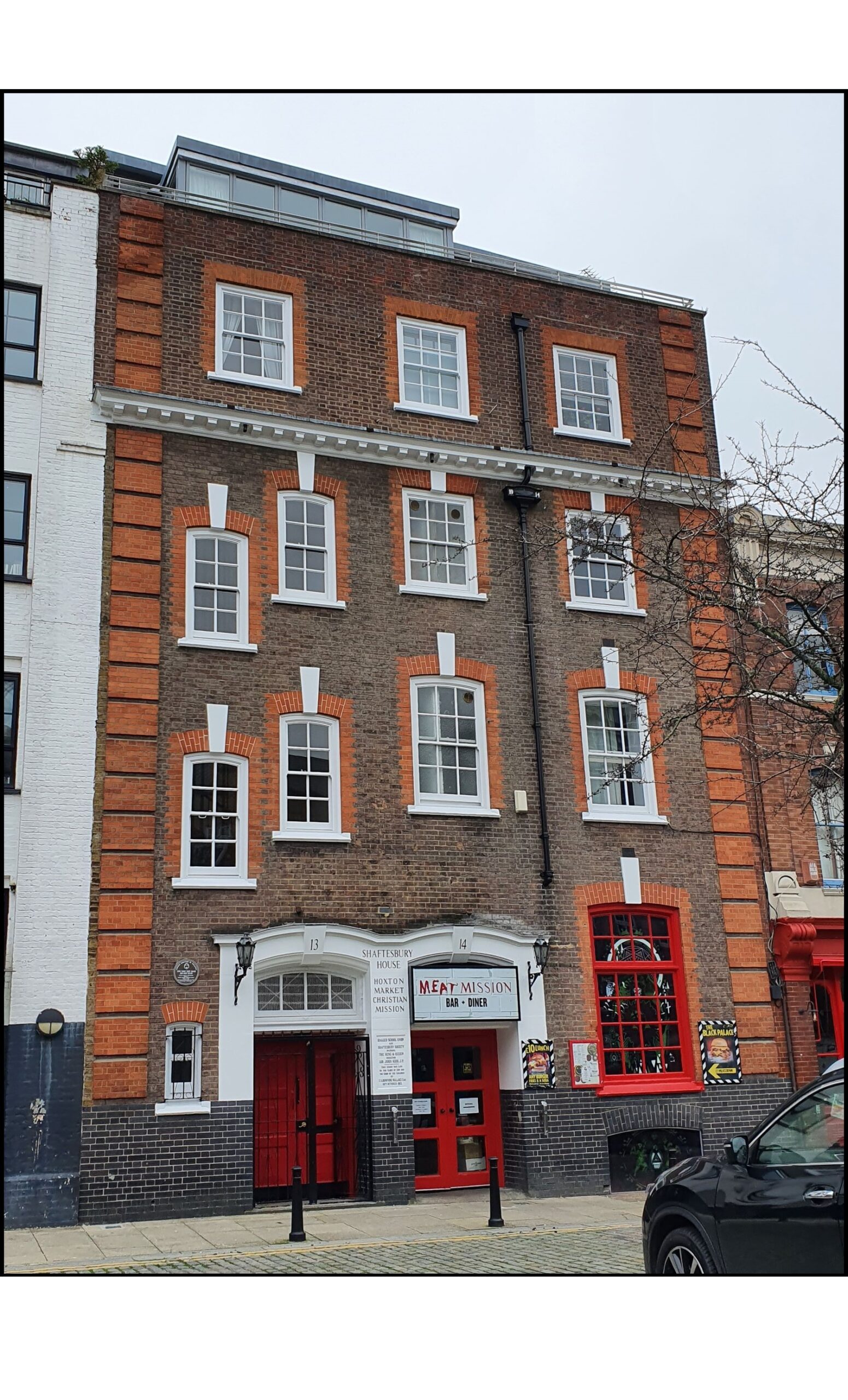
←13 Hoxton Market, the Mission’s purpose-built home from 1915 to its demise in the 1980s. A commemorative plaque is to the left, above the barred window. The Mission, created within the community it served, is remembered with obvious affection by many.
Part of Empire House is occupied by the National Association of Citizens Advice Bureaux for at least 15 years from 1986; another tenant is the nearby Moorfields Eye Hospital. The freehold is purchased for £3.25m in early 2000 with the likely intention of redevelopment as leases expire. As the building falls empty it is occupied by squatters and used for illegal raves.
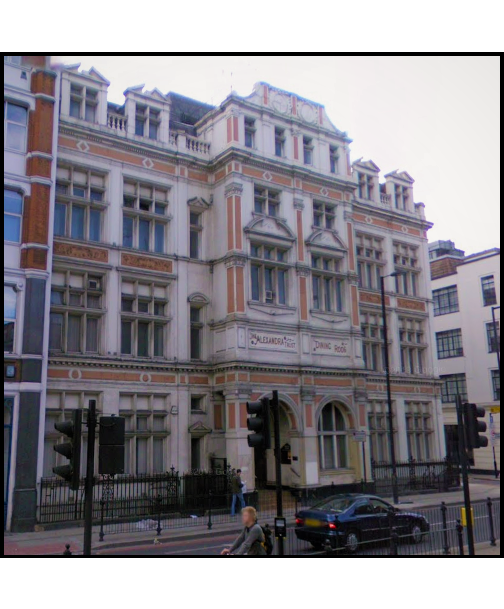
← The decrepit Empire House in 2008, a sad state for a building that once rocked to the sound of 2,000 kids having high tea.
The fading paint job tries to give an impression of Portland stone and terracotta. The central bays were originally topped at roof level by a broken pediment similar to those on the dormer windows on either side. This was probably lost in the Blitz and the 2014 works sadly did not reinstate it.
Empire House undergoes a major refurbishment 2014-15 as part of the trendy Bower quarter. Most of the building is taken by the budget boutique hotel chain ‘Z’, with former dining areas on the 1st and 2nd floors, and the basement, reconstructed as bedrooms. Later partition walls on the ground floor are removed, and the restored former dining area there opens as a branch of the Ceviche Peruvian restaurant chain. The original white wall tiles, ideal for catering to the great unwashed masses, are retained here as they are no doubt now seen by trendy types as chic and evocative of the Edwardian era.
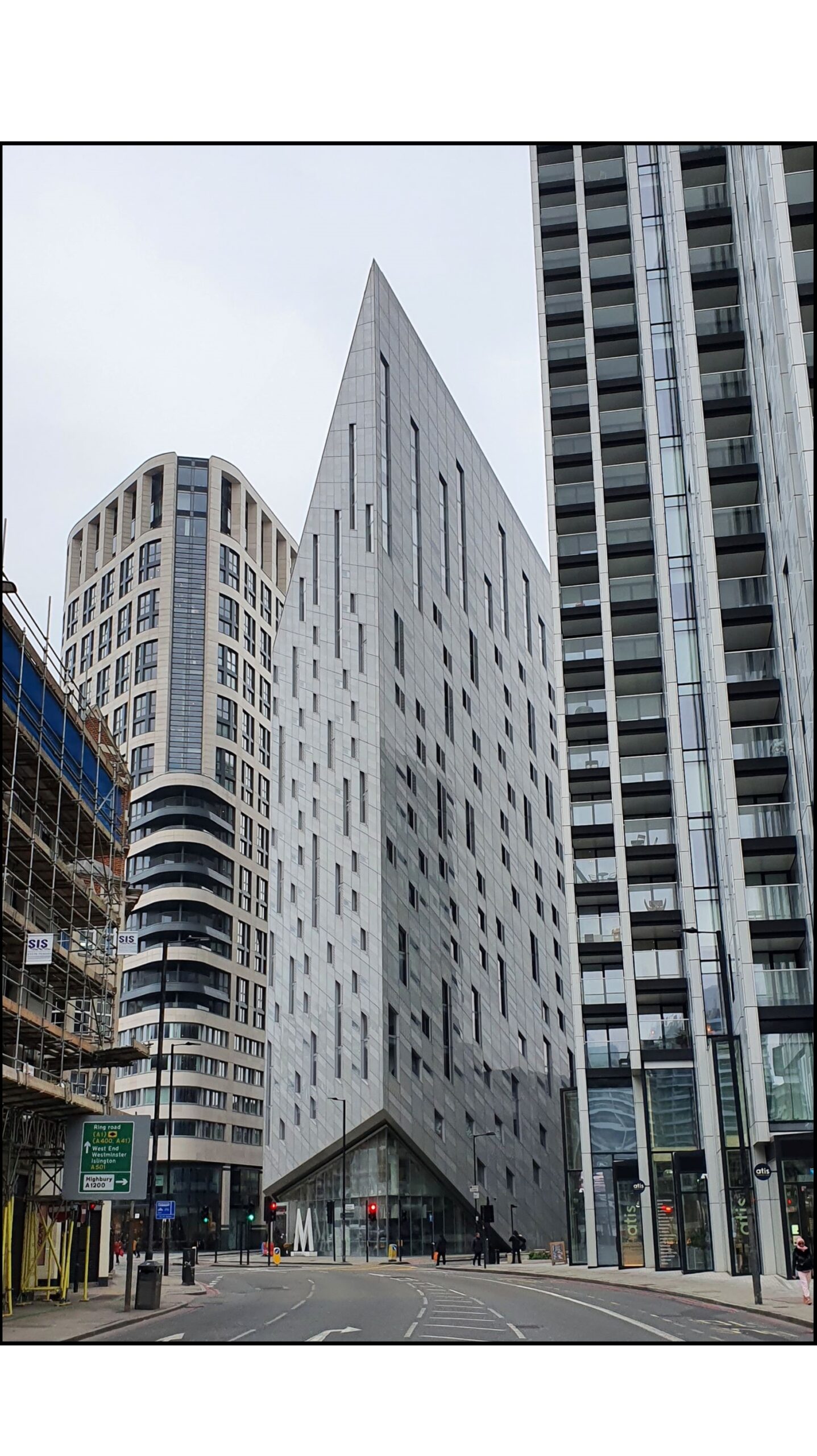
→ The headache-inducing modern architecture of City Road. These are the near-neighbours of Empire House, which is just out of shot immediately to the left of the photographer.
In 2020 the Alexandra Trust charity, dedicated to ‘the general benefit of poor persons’, still operates in the East End. It doesn’t actively seek public donations so presumably raises funds – £17,600 in 2019 – from investments or corporate donations. This money is distributed to homeless charities and organisations, like the 999 Club in Deptford, The Pavement magazine for the homeless, and the Whitechapel Mission. Spare a moment to compare £17,600 with the £20.65m paid for the freehold of Empire House this year, a figure reflecting the increasing desirability of the area. I wonder if the buyers thought to donate a few pounds to the Trust whose name still appears on the frontage.

Nearest Station: Old Street
Selected Bibliography:
Credits: